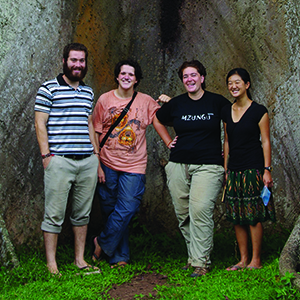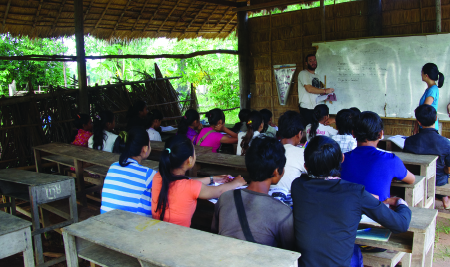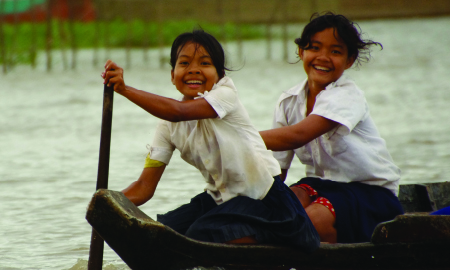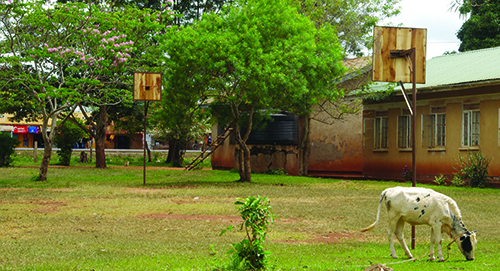Paths to People Establishing a Humanist Service Corps
 THE PATHFINDERS (from left): Conor Robinson, Ben Blanchard, Wendy Webber, and Michelle Huey. Photo by Wendy Webber
THE PATHFINDERS (from left): Conor Robinson, Ben Blanchard, Wendy Webber, and Michelle Huey. Photo by Wendy Webber The Pathfinders have been to rural Cambodia, teaching English to children at dawn before they head off to the rice fields. We have sung science songs with students in Uganda while teaching them to use computers. In Ghana we have educated junior high school students about hygiene, HIV/AIDS, and menstruation. We four—Ben Blanchard, Michelle Huey, Conor Robinson, and myself—are the initial team of the Pathfinders Project.
Over the course of a year we are partnering with social justice organizations in eight countries on four continents. We are laying the groundwork to establish a permanent Humanist Service Corps (HSC), which will fill a global service and justice hole. HSC will also provide an opportunity for humanists to put their humanism into action—to be humanists helping humans and bringing people together.
Sponsored by Foundation Beyond Belief, the Pathfinders Project does in the name of humanity what many have done in the name of their country or their religion. Good works are built on the foundations of caring people and need not work under such banners. The work we’re doing is what’s important. We will have definite positive impacts on the lives of people around the world. But just as important are the human connections we make. Pathfinders are committed to finding paths to people everywhere—regardless of race, color, creed, class, or nationality. Humanism is globalism.
CAMBODIA

Pathfinders teaching in Kampong Thom, in rural Cambodia. Photo by Wendy Webber
Our missions and the organizations we partner with vary wildly. Our first partner was the Bridge of Life School based out of Siem Reap, Cambodia. Bridge of Life School runs several schools in Cambodia that teach English to impoverished students. Our English classes were supplemental to the children’s regular education, so we had to meet before or after school at a local pagoda. We taught the youngest kids the ABCs by playing games with our portable white boards. Michelle was always their favorite (she probably played more patty-cake games than the rest of us combined). With the older kids we worked a lot on pronunciation. I’m not sure how great an impact we had on their English skills in the time we were there, but I do think we had an impact on their human skills by letting them meet and interact with people so different from themselves.
For me, the best part of our work in Cambodia had to do with the fact that we were humanist volunteers working with Buddhist monks to teach Christian and Buddhist students—a truly cooperative, interbelief endeavor. The monks didn’t participate in the classes but donated the use of buildings at their pagoda, and when we Pathfinders would enter the pagoda grounds, the monks were often as eager to greet us as the children.
When Conor and I first met the local chief, he commented (in hesitant, broken English) about how wonderful it was that we—the Pathfinders, Bridge of Life School, and the monks—were working together to help children in such desperate need. Before we left, the chief tied a red bracelet traditionally symbolizing bravery onto each of our wrists. Tying a bracelet on another’s wrist signifies unity. As he tied the bracelets the chief wished us long life. Conor and I plan to let the bracelets fall off naturally in their own good time.
We spent one week teaching at another pagoda in rural Cambodia. In Kampong Thom, we slept on thin mats on a wooden floor in a house built on stilts because of annual flooding during the wet season. We stayed with the local English teacher who, though greatly respected in town, had no electricity in his home. And the toilet was two houses down, past the neighbors and their cows, chickens, and barking dogs. Truly, I loved it.
I also loved that we spent the week unplugged. We walked up and down the one road through town. We met with our host’s family and sat cross-legged on the floor. Although they didn’t speak English—and we didn’t speak Khmer—we all communicated in the universal language of laughter. We napped in hammocks during the day and tried local alcohols with the men at night. The fact that Michelle and I would sit and drink with the men struck them as bizarre. On the other hand, their snacks were absolutely bizarre to us—instead of peanuts or chips they served bite-sized grilled fish caught in the standing water of the rice paddies.

Kampong Klein students rowing to school. Photo by Wendy Webber
Choosing my favorite moment in Kampong Thom is hard, but certainly near the top of the list is when several women from the village came to the house. They wanted to thank us for coming, thank us for teaching their children. Though we couldn’t communicate much with language, we had no problem connecting as just plain people. We could hold each other’s gazes. We could laugh. They could and did say, repeatedly, “Come back, come back. Stay longer, come back.” That’s our plan.
We had to get up at 5:30 am every morning to get to the pagoda for classes at six. Our early morning students had to head to the rice fields when class was over. English class is optional and in addition to regular school. (The week we were there happened to be a school holiday, which is why they were working instead.) These students were choosing to get up at or before dawn to walk to English class before toiling in the fields all day. They value their education and have a lot to teach those of us who take ours for granted.
Such appreciation was especially evident in the children in another village called Kampong Klein. In the wet season, these children have to row up to thirty minutes just to get to dry land to walk or catch a bus to school. In Kampong Klein we visited the Khmer language school run by the Bridge of Life School for the children whose parents couldn’t spare a boat. Before the Bridge of Life school opened, these students had no access to education at all.
AFRICA
In Uganda we visited two schools that each had very different missions and challenges compared to the schools in Cambodia. The first was called the Kasese Humanist Primary School (KHPS), located in the western Ugandan town of Kasese. That a humanist school exists in this country is remarkable in and of itself. Uganda is overwhelmingly religious—mostly Christian, though there is a sizable Muslim minority—and much attention has been paid to the U.S. evangelical influence here, especially with the anti-homosexuality law passed in February.
While the Ugandan constitution claims no state religion, “Religious Education” is a required course with a religious exam that must be passed to graduate from one school to the next. The exam questions aren’t based on objective study of Christianity or Islam, but rather pose faith-based questions requiring students to answer how God is present in their lives or who their savior is. (And no other traditions are even mentioned.) Younger students are asked to identify pictures of God’s creations—various plants and animals—rather than simply being asked to identify pictures of living things.
While KHPS must teach religious education, this school focuses on science as the foundation of knowledge and teaches students to encounter the world around them critically. During our stay, we taught humanist workshops focused on the benefits of mutual cooperation, evidence-based knowledge, and seeking happiness for yourself and others. The students held debates with proposals like “one can be good without God” and “science and technology have done more harm than good in Uganda.” Ben helped at least one student fall in love with science. At the beginning and end of our time there, he asked his P7 science students what dream careers they had in mind. The student, who had no answer at the beginning, answered “astrophysicist” at the end.
At KHPS, my greatest joy came from the religious education classes. My assignment made sense, considering I have a masters of religion degree, but that didn’t mean I had a clue as to what to do. How do you teach religion in a humanist school in a coercively Christian nation? I decided to go with a world religions seminar. Each meeting we explored a different major religion. These students knew Christianity very well, knew a bit about Islam, but had never even heard of Judaism, let alone Hinduism, Buddhism, or Sikhism. I threw in Baha’i too since the one Baha’i temple in Africa is in Kampala.
I definitely heard titters and expressions of disbelief when I introduced polytheism, and students were blown away by the number of Hindus in the world. I’m glad I got to open this window to the world for them. But what I liked most came during group discussion at the end of each class with questions like: Is one world government a good idea? (Baha’i); How does belief in reincarnation affect how one lives her or his life? (Hinduism); How is meditation like Christian prayer and how is it different? (Buddhism). These were lively and serious discussions during which I was able to really get to know the students and they were able to learn about me beyond the role of white, American teacher.

The Pathfinders built a basketball court at the Mustard Seed Secondary School in Busota, Uganda. Photo by Wendy Webber
Leaving Kasese, we took a fourteen-hour bus trip across Uganda to Busota where we volunteered at another humanist school—Mustard Seed Secondary School. We helped with English and science classes and helped fix computers in the computer lab. With some volunteer students we planted shade and fruit trees on campus. We leveled an outdoor basketball court and then Conor taught interested students how to play the game. We taught a few seminar classes we called “Science versus Superstition.” During these class periods we taught the scientific method and asked students to design an experiment to test whether pendulums could really find water.
In Busota we had quite a bit more free time than we had in Kasese. I spent many days reading and writing in the teachers’ lounge (a little smaller, with more dirt on the ground, more bugs, and less furniture than you might imagine) or sitting out under the trees. When other teachers were around we would talk about religion, politics, anything. My favorite teacher was their new English teacher, who was so passionate about drama but lamented the lack of interest shown by his Mustard Seed students. He told me that English literature is considered a “difficult” subject that only a few—three at the time—continue once it’s no longer mandatory. He was working to nurture a love of literature in the younger students so that he could then start a drama club at the school.
We had a number of question-and-answer sessions where the students were free to ask us anything. What do we eat in the United States? What is the weather like? What is our industry? they asked. But these were just the warm-up questions. Then the real questions started popping up: Is it true that even children have guns in the United States? Why is the U.S. forcing its homosexual agenda on Uganda? Is it true that some Americans don’t worship Jesus—but worship Buddha instead? They asked about U.S. involvement in Iraq, Iran, and Syria; U.S. immigration policy; and governmental corruption. Many of these questions came from places of misinformation—based on myths or half-truths. But the nature of the questions gave a sense of the students’ impressions of the United States and its people. I can only hope that we were able to replace some misimpressions about Americans with some better ones about four human beings who happen to be American.
When our service in Uganda was complete, we moved on to Ghana and into a whole other gear. We worked with the Alliance for African Women Initiative (AFAWI) on their goal to empower and improve the lives of some of the most vulnerable people in society: impoverished women and children and people living with HIV/AIDS. Working in schools educating young people about safe sex and menstrual hygiene, AFAWI also supports a microfinance program for vulnerable women starting independent businesses. We worked with the organization’s Teen Club, an afterschool leadership program.
Teen Club only met once a week, so the rest of the time we worked on funding a library and computer lab for the Taifa Community School, which housed three separate junior high schools—and yet had no library. While there were computer classes taught from books—there were no computers. Many students never even saw a computer until they sat for their computer exam.
Ghanaians are very friendly. When we arrived at AFAWI the director told us to expect to be greeted constantly as we walked around. He wasn’t kidding. In Uganda children had waved and shouted “muzungu” (white person) to get our attention. Then they would often giggle and run away or hide behind the closest tree or parent. In Ghana we got this too—except it was “obruni” instead of “muzungu,” and here it wasn’t just the kids who did it. Because of his beard, Conor was often greeted on the street by the names Jesus, Moses, or, somewhat strangely, Rick Ross (an African-American rapper popular in Ghana).
The director of AFAWI also told us to make sure that we too greeted the people that we passed—especially old people and especially people in our neighborhood. We made a point to do this. Older people really lit up when we greeted them, and we made good friends in our neighborhood. There was the woman who ran the shop across from our office called “Cry Your Own Cry,” and the women who ran the restaurant where we ate dinner every night. There was our next-door neighbor from whom we sometimes bought red red, a common dish of beans and plantains made red with palm oil. And there were the men at the tro tro depot (a “tro tro” is a mode of transportation somewhere between a bus and a taxi) who asked us where the others are when we were traveling alone.
My favorite friend in Ghana was the woman who made some clothes for us. We had to first choose our fabrics, so she escorted us to the fabric market. About every piece of cloth we would look at, she would ask, “Do you love it?” She wanted us to love it. On the tro tro ride home she and I talked about how sewing came to be her profession (she’d attended fashion school fifteen years earlier), about her friend who couldn’t come to the market during Christmas buying season (too crowded and smelly for the friend), and about how her daughter doesn’t want to have anything to do with sewing (she wants to be an artist).
PERMANENT PATHFINDERS
With our initial service tours of Asia and Africa complete, we’re spending our final months in Latin America. (Michelle has recently returned to the United States to continue working on causes at home.) As pathfinding has become a way of being, we find the humanity in human beings wherever we go.
My fellow Pathfinders and I have each had our own individual goals that are fundamentally interrelated. My own mission, with and beyond Pathfinders, is to get atheists, agnostics, and other “nones” invited into interfaith—I call it interbelief—discussions. And to get Christians, Jews, Muslims, Buddhists, and others invited into humanist discussions. All of us deserve real seats at the human table at which peace and justice are truly served. My goal as a Pathfinder has been to do this work on a person-to-person basis—to work next to and with Buddhists, Christians, Muslims, and people of any other belief system encountered on projects serving humanity—globally, locally, or individually. When someone meets me—one of the “nones”—and sees that I’m not evil or hateful, an essential part of the work is done.
This doesn’t mean we won’t continue to have difficult discussions. One student at Mustard Seed asked Ben and me if Americans sacrifice animals to appease spirits. She asked us about demon possession and faith healings. She asked us these things because they are a part of her human experience and part of her personal story. She wanted to find out how common her beliefs are in the United States. And, whether she knew or suspected that we did not share these beliefs with her, she was trying to convince us of their validity. She told us a story about a student at Mustard Seed who’d recently been possessed and was only saved by the intervention of a nearby Christian church.
This was a very difficult discussion. I had just finished two years in divinity school and am quite used to talking to people who have beliefs far different from my own. But this was somehow different. I was her teacher, a guest in her land, and a foreigner to her culture—but I wanted to teach her about mine. I was at her school as a humanist, but not as an evangelist for humanism, and so I wanted to have a discussion with her that was mutually respectful of our differing beliefs. This is my mission as a Pathfinder.
The Pathfinders Project has its organizational mission, which is to find the right location to launch the HSC and to effect some good along the way. But beyond that, the most important thing we all do is meet people—have conversations, share meals, make friends. Be human together.
We met the onsite manager of our hotel in Cambodia who took us home to eat a family meal cooked by his mother. We met the Cambodian men who live in and around the pagoda and played volleyball with them. We met the keeper of the shop across the street from our house in Kasese, who brought us a home-cooked lunch when she rightly guessed one of our group was at home sick. We met the owner of the guest house in Kamuli who took hours out of his Sunday to show us around the town and teach us the history of the area. We met the Ghanaian woman who runs the Peace and Love Drinking Spot across the street from our guest house and who enticed us with American movies. We met the Ghanaian woman who sold us lunches and who laughed when I approached because my lunch orders struck her as so bizarre.
Making such wonderful friends around the world, we find that the path is not one of simple service or one-way giving. Wherever we go, we find that encountering the humanity in others serves us all—in generous portions.
